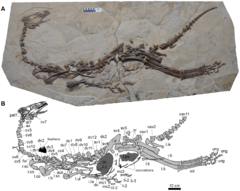Jianchangosaurus
| Jianchangosaurus | |
|---|---|

| |
| Holotype specimen | |
| Scientific classification | |
| Domain: | Eukaryota |
| Kingdom: | Animalia |
| Phylum: | Chordata |
| Clade: | Dinosauria |
| Clade: | Saurischia |
| Clade: | Theropoda |
| Clade: | †Therizinosauria |
| Genus: | †Jianchangosaurus Pu et al. 2013 |
| Type species | |
| Jianchangosaurus yixianensis Pu et al. 2013
| |
Jianchangosaurus is a
Discovery and naming
The holotype specimen, 41HIII-0308A, was discovered on the
Description

The holotype specimen of Jianchangosaurus 41HIII-0308A is a nearly complete skeleton of a single juvenile individual, missing only the distal portion of the tail. Jianchangosaurus was estimated to have been 1 m (3.3 ft) tall at the hips and approximately 2 m (6.6 ft) long.[1] Gregory S. Paul estimated the weight of the holotype specimen around 20 kg (44 lb).[2]

Five sacral vertebrae are present in this genus, a condition that is similar to that of other basal therizinosaurs. The humerus measures 158.5 mm (6.2 in) in length and is 7% shorter than the scapula. The ulna measures 12.43 cm (124.3 mm) in length and is 78% of the humerus length - which approximates the ratio observed in the basal therizinosaur Falcarius (77%). The pubis is 20% longer than the ischium, and it projects anteroventrally and does not exhibit the opisthopubic condition. The tibia (31.6 cm (316 mm)) is 1.5 times longer than the femur (20.6 cm (206 mm)), which is the highest ratio known in therizinosaurs, an adaptation which has been strongly correlated with the development of cursorial habits in dinosaurs.[3][1]
Distinguishing anatomical features

According to Pu et al. 2013, Jianchangosaurus can be distinguished based on the presence of 27 tightly packed
Skull and dentition

The skull is in good preservation and is nearly complete, missing only the ventral
The front portion of the lower jaw is down-turned and in combination with the rhamphotheca on the upper jaw, functioned to pluck food. The skull measures 23 cm (230 mm) in length, and is 10% longer than the femur, a condition not shared by Beipiaosaurus. Derived features present in the skull of this genus strongly suggest adaptations for herbivory.[1]
Jianchangosaurus possesses 27 maxillary teeth and approximately 25 to 28 dentary teeth.[Note 2] The crowns on its teeth diminish in size as they progress toward the posterior of the skull. The teeth on the upper jaw, exhibit the conventional dental morphology - in which the surface of the tooth facing the outside of the mouth is convex. The teeth on the lower jaw possess the reversed morphology, where the surface of the tooth facing the outside is concave. Pu et al. 2013 noted that this dental morphology "likely maximized the biting stress during occlusion to cut fibers of plant material, similar to ornithopods and ceratopsians".[1]
Feather impressions

The impressions of a series of wide and unbranched feathers were discovered with the fossils. Only the distal ends of the feather impressions are visible. Based on their morphology the feathers are considered primitive and bear resemblance to those found along the neck of Beipiaosaurus, which were collected in the same formation. The authors noted that the "presence of elongated broad filamentous feathers (EBFF) suggests that they might have been used for visual display".[1]
Ontogenetic stage
The only known Jianchangosaurus skeleton is that of a juvenile individual. The morphological evidence supporting ontogenetic immaturity consists of the observation that the neurocentral sutures are open (i.e. not fused) in all of the cervical and dorsal vertebrae, as well as in the cervical ribs and in the sacral centra. The scapula and coracoid are also unfused, which the authors indicate may be an ontogenetic feature in Jianchangosaurus also suggesting that is a juvenile. This condition, however, is also observed in adult basal therizinosaurs.[5][1]
The validity of Jianchangosaurus was called into question by Cau (2024), who considered it to be a
Classification
Like the primitive Falcarius and Beipiaosaurus, Jianchangosaurus was classified as a
Left cladogram is based on the phylogenetic analysis conducted by Pu et al. 2013, showing the relationships of Jianchangosaurus as a very primitive therizinosaur.[1] Right cladogram is based on Hartman et al. 2019 which has corroborated the position of Jianchangosaurus:[7]
|
|
See also
Notes
References
- ^ PMID 23734177.
- ISBN 9780691167664.
- S2CID 84505681.
- JSTOR 1369622.
- .
- .
- PMID 31333906.
